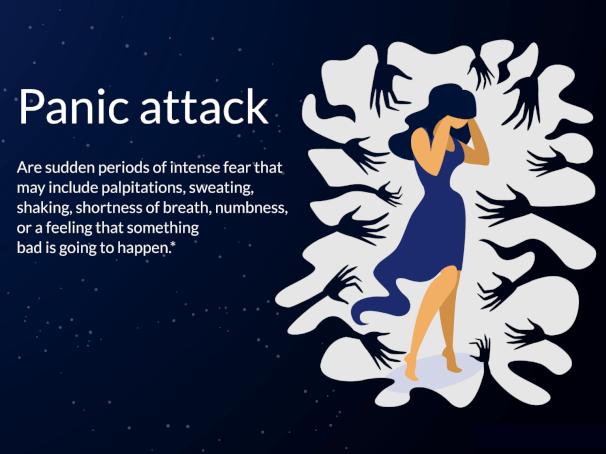
Driving a car is considered a normal part of being an adult. Driving a car is also inherently stressful. Many people tense up at points during their drive - especially while on the freeway - but tensing up becomes so natural that they may not even realize they're doing it.
Combine that with the natural feeling of being unable to escape if something went wrong, and it's no wonder that so many people have panic attacks while driving.
Driving Fears are Normal
A basic fear of driving is not too much of a problem. In fact, a little bit of anxiety may actually be healthy. It will keep you alert and focused on what's around you, improving your ability to stay safe.
But panic attacks while driving can be terrifying. Panic attack symptoms can overwhelm the senses and actually make it more difficult to drive.
Why Panic Attacks Are Common in the Car
Panic attacks while driving are very common. You should note that even though panic attacks can be a bit overwhelming, you should still generally be safe. If you're concerned, pulling over to the side of the road until the panic attack is over may be a good idea.
There are several different factors that can contribute to driving panic attacks. These include:
- General Stress Panic attacks are more common when you're stressed, and as mentioned, stress when driving is completely natural. There are a lot of dangers on the road. Your driving ability is what keeps you safe, and part of that driving ability comes from being alert.
- Thinking About Panic Attacks One cause of panic attacks is thinking about panic attacks. It's the catch-22 of panic disorder. It's very common to think about your panic attacks or even fear panic attacks when you drive, and that fear actually increases the likelihood that you'll experience one.
- Driving Hyperventilation Many things can cause you to hyperventilate while you're driving. The way you're sitting, your fear, and even your seatbelt may contribute to mild to moderate hyperventilation. In those with anxiety, hyperventilation is both a cause and a symptom of panic disorder, and so, if you hyperventilate for any reason while driving, it's likely to trigger an attack.
- General Sitting Pains Driving can cause a number of pains and sensations that may trigger panic attacks. Those with panic disorder are over-sensitive to the way their body feels. So if they feel any light pains, an increase in heart rate, leg weakness, or anything else that commonly affects those that sit in cars often, it may cause a panic attack.
- Panic Attacks and Danger Panic attacks can become associated with various activities, especially if those activities cause any stress or anxiety. If you previously had a panic attack in the car it may increase the likelihood of having another attack because your brain now associates the car with the attack. You'll also likely experience further fear when you try to keep driving during the attack and so your car becomes a place that is even less comfortable.
The latter point is often a big problem for those with panic attacks. As soon as you've had an attack in the car, even if it's unrelated to being in the car, the attack will often become associated in your mind with the anxiety of driving, and future attacks may become more common.
How to Control Panic Attacks While Driving
Driving panic attacks are obviously very difficult to live with. You drive everywhere, and if you're also dealing with severe panic attacks, then you're going to be extremely scared while on the road.
The key to preventing these car attacks is to learn to prevent all panic attacks. It's hard to cure panic attacks in only one location since panic attacks can occur anywhere, and any time you have a panic attack you put yourself at risk for associating the attack with the location and having these attacks more often. You can, however, try the following:
- Driving With Distractions Give yourself something to listen to so that you can get out of your own head. Music can help but it may be better to listen to something happy, relaxing, or even talk radio or podcasts in order to give yourself something to think about. That will make it harder to focus on the attack and how you feel.
- Driving Anyway Depending on how severe your attacks are, you may want to try driving anyway. Those that get very dizzy during their panic attacks may find driving to be too difficult. But those that can still drive should strongly consider facing their fear and driving anyway. The more you fear driving with panic attacks, and the more you avoid driving because of them, the more likely you'll get a panic attack in the future when you do hit the road.
- Drive Safely Stress is a major contributor to panic attacks. By driving safely you reduce the amount of stress you are under. Drive the speed limit, take very few risks, keep a GPS in the car so that you're not worried about getting lost, and don't try to swerve around traffic. All of those behaviors increase stress, and stress increases the likelihood of a panic attack.
- Controlled Breathing Stress can cause your breathing to quicken, which can lead to hyperventilation and panic attacks. When you feel like you're having a panic attack, don't try to take in as much air as possible. Instead, try to fight the urge and simply slow down your breathing so that each breath takes as long as 15 seconds or more. You should breathe in for 5 seconds, hold for 2 or 3, and breathe out for 7. This will prevent hyperventilation and improve carbon dioxide levels in the blood stream. By taking longer, deeper breaths you can calm your heart rate and your breathing which will help the panic attack to pass.
- Practice Driving for Extended Periods of Time The more exposure to driving you have the more comfortable you will get with it. While you may experience periods of anxiety, by facing your fear and driving anyways you can see that driving does not have to be as stressful as you may be making it out to be. See if a trusted friend can come with you for reassurance and drive in a familiar area near your home. Pick an easy route that has lower speed limits and minimal traffic. Once you drive for a long period of time, 20-30 minutes, you may actually find that it becomes relaxing.
None of these are going to act as a rapid cure for anxiety, nor are they going to provide you with a way to prevent all of your anxiety and panic attacks. But they may reduce either the frequency or severity of your anxiety attacks while driving so that hopefully you'll find it easier to be on the road.
Ultimately, the solution is going to be learning how to manage your anxiety. Only then will you give yourself the best opportunity to prevent any and all panic attacks while in the car.









